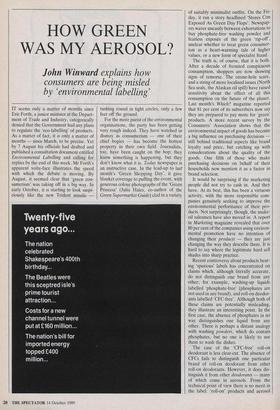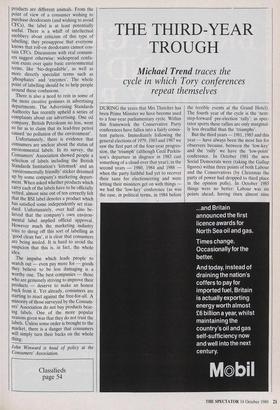HOW GREEN WAS MY AEROSOL?
John Winward explains how consumers are being misled by 'environmental labelling'
IT seems only a matter of months since Eric Forth, a junior minister at the Depart- ment of Trade and Industry, categorically denied that the Government had any plans to regulate the 'eco-labelling' of products. As a matter of fact, it is only a matter of months — since March, to be precise. Yet by 7 August his officials had drafted and published a consultation document entitled Environmental Labelling and calling for replies by the end of this week. Mr Forth's apparent volte-face illustrates the speed with which the debate is moving. By August, it seemed clear that 'green con- sumerism' was taking off in a big way. In early October, it is starting to look suspi- ciously like the new Trident missile —
rushing round in tight circles, only a few feet off the ground.
For the more purist of the environmental organisations, the party has been getting very rough indeed. They have watched in dismay as consumerism — one of their chief bogies — has become the hottest property in their own field. Journalists, too, have been caught on the hop; they know something is happening, but they don't know what it is. Today newspaper is an instructive case. In the lead-up to last month's 'Green Shopping Day', it gave blanket coverage to puffing the event, with generous colour photographs of the 'Green Princess' (Julia Hales, co-author of the Green Supermarket Guide) clad in a variety of suitably minimalist outfits. On the Fri- day, it ran a story headlined 'Stores Con Exposed As Green Day Flops'. Newspap- ers waver uneasily between exhortations to buy phosphate-free washing powder and fearless exposés of the green `rip-off', unclear whether to treat green consumer- ism as a heart-warming tale of higher values, or a new form of specialist fraud.
The truth is, of course, that it is both. After a decade of frenzied conspicuous consumption, shoppers are now showing signs of remorse. The ozone-hole scare, and a string of more localised issues (North Sea seals, the Alaskan oil spill) have raised sensitivity about the effect of all this consumption on the future of the planet. Last month's Which? magazine reported that 81 per cent of its subscribers now say they are prepared to pay more for 'green' products. A more recent survey by the Consumers' Association shows that the environmental impact of goods has become a big influence on purchasing decisions still behind traditional aspects like brand loyalty and price, but catching up with considerations about the quality of the goods. One fifth of those who make purchasing decisions on behalf of their households now mention it as a factor in brand selection.
It would be surprising if the marketing people did not try to cash in. And they have. At its best, this has been a virtuous activity, with the more responsible com- panies genuinely seeking to improve the environmental performance of their pro- ducts. Not surprisingly, though, the snake- oil salesmen have also moved in. A report in Marketing magazine revealed that over 80 per cent of the companies using environ- mental promotion have no intention of changing their products — they are just changing the way they describe them. It is hard to .say where the legitimate hard sell shades into sharp practice'.
Recent controversy about products bear- ing 'spurious' labels has concentrated on claims which, although literally accurate, do not distinguish one brand from any other; fora example, washing-up liquids labelled 'phosphate-free' (phosphates are not used in any brand), and roll-on deodor- ants labelled `CFC-free'. Although both of these claims are potentially misleading, they illustrate an interesting point. In the first case, the absence of phosphates in no way distinguishes one liquid from any other. There is perhaps a distant analogy with washing powders, which do contain phosphates, but no one is likely to use them to wash the dishes.
The case of the `CFC-free' roll-on deodorant is less clear-cut. The absence of CFCs fails to distinguish one particular brand of roll-on deodorant from other roll-on deodorants. However, it does dis- tinguish it from other deodorants — many of which come in aerosols. From the technical point of view there is no merit in the label: `roll-on' products and aerosol
products are different animals. From the point of view of a consumer wishing to purchase deodorants (and wishing to avoid CFCs), the label is at least potentially useful. There is a whiff of intellectual snobbery about criticism of this type of labelling; they presuppose that everyone knows that roll-on deodorants cannot con- tain CFCs. Discussions with real consum- ers suggest otherwise: widespread confu- sion exists over quite basic environmental terms, like `bio-degradable', as well as more directly specialist terms such as `phosphates' and 'enzymes'. The whole point of labelling should be to help people around these confusions.
There is also a need to rein in some of the more creative geniuses in advertising departments. The Advertising Standards Authority has recently upheld a series of complaints about car advertising. One oil company, British Petroleum no less, went so far as to claim that its lead-free petrol caused `no pollution of the environment'.
Unfortunately, there is evidence that consumers are unclear about the status of environmental labels. In its survey, the Consumers' Association showed people a selection of labels including the British Standards Institution's `Icitemark' and an `environmentally friendly' sticker dreamed up by some company's marketing depart- ment. When asked whether products which carry each of the labels have to be officially vetted, almost nine out of ten correctly felt that the BSI label denotes a product which has satisfied some independently set stan- dard. Unfortunately, over half also be- lieved that the company's own environ- mental label implied official approval. However much the marketing industry tries to shrug off this sort of labelling as `good clean fun', it is clear that consumers are being misled. It is hard to avoid the suspicion that this is, in fact, the whole idea.
The impulse which leads people to search out — even pay more for — goods they believe to be less damaging is a worthy one. The best companies — those who are genuinely striving to improve their products — deserve to make an honest buck from it. Yet already, consumers are starting to react against the free-for-all. A minority of those surveyed by the Consum- ers' Association do not buy products bear- ing labels. One of the more popular reasons given was that they do not trust the labels. Unless some order is brought to the market, there is a danger that consumers will simply turn their backs on the whole thing.
John Winward is head of policy at the Consumers' Association.



























































 Previous page
Previous page